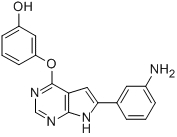TWS119
| CAS No. | 601514-19-6 | Cat. No. | BCP02458 |
| Name | TWS119 | ||
| Synonyms | TWS 119;TWS-119; | ||
| Formula | C18H14N4O2 | M. Wt | 318.33 |
| Description | Treatment of a monolayer of P19 cells with 1 μM TWS119 causes 30–40% cells to differentiate specifically into neuronal lineages based on counting of TuJ1 positive cells with correct neuronal morphology (up to 60% neuronal differentiation occurred through the standard EB formation protocol with concomitant TWS119 treatment). TWS119 tightly binds to GSK-3β (K D = 126 nM) which is quantified by surface plasmon resonance (SPR) and further demonstrates an IC50 of 30 nM. TWS119 is found to potently induces neuronal differentiation in both mouse embryonal carcinoma and ES cells. TWS119 treatment towards hepatic stellate cells (HSC) leads to reduced b-catenin phosphorylation, induces nuclear translocation of b-catenin, elevates glutamine synthetase production, impedes synthesis of smooth muscle actin and Wnt5a, but promotes the expression of glial fibrillary acidic protein, Wnt10b, and paired-like homeodomain transcription factor 2c. TWS119 triggers a rapid accumulation of β-catenin (mean 6.8 | ||
| Pathways | Wnt/Stem Cell PI3K/Akt/mTOR | ||
| Targets | GSK3 | ||
Structure

Part data of this page collected from the open network resources, so Biochempartner can not guarantee its accuracy.
For product details of different batches, please contact our Customer
- Service & Tech Support:orders@biochempartner.com
- Website:www.biochempartner.com
Products are for research use only and not for human use. We do not sell to patients.
